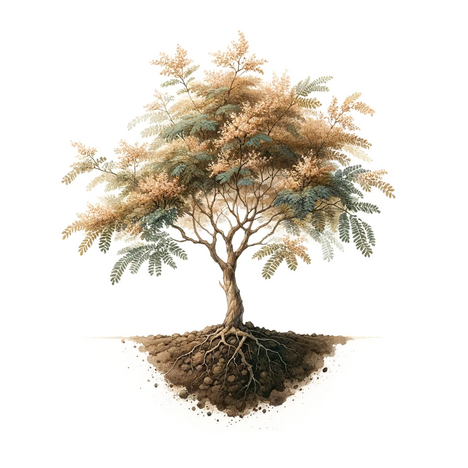Acacia tree

Acacia tree 101: What dog owners need to know
The composition of the acacia tree
The acacia tree is characterized by its unique composition. It contains:
- Phytochemicals: naturally occurring chemicals found in the leaves, bark and seeds of the tree. Some of these compounds can be toxic to dogs.
- Tannins: Found in the bark and in smaller amounts in the leaves, these substances are known to cause gastrointestinal distress if ingested in excess.
- Essential oils: While they may have therapeutic properties in small amounts, essential oils are potentially toxic to dogs in higher doses.
The risks for dogs
There are reports suggesting that certain parts of the acacia tree, particularly the bark and seeds, can be toxic to dogs if consumed in large quantities. Symptoms of poisoning can include vomiting, diarrhea and, in severe cases, central nervous system depression. It is important to emphasize that toxicity can vary depending on the species of acacia, the amount ingested and the individual dog.
Safety precautions and recommendations
What to do if your dog has consumed acacia parts?
If your dog has ingested parts of an acacia tree, it is important to act quickly. Watch him for signs of poisoning and consult a vet immediately if you have any concerns. Early detection and treatment are crucial to your dog's health and well-being.
Preventative measures
- Restrict access: Make sure your dog does not play or loiter unsupervised near acacia trees.
- Education: Learn to identify the different acacia species and be aware of which ones grow in your area.
- Look for alternatives: Consider planting dog-friendly alternatives in your yard to minimize the risk of accidental ingestion.
While the acacia tree has many positive environmental and aesthetic qualities, it's important that dog owners are aware of the potential dangers it can pose to their furry friends. Through knowledge, caution and preventative measures, you can help create a safe and happy environment for your dog. Ultimately, it is the responsibility of every dog owner to educate themselves about the natural environment and its effects on their pets. In this way, we can strengthen the bond with our faithful companions while ensuring their health and safety.
Properties 7
Are you looking for other ingredients with a specific property?
Just click on them to find more.
If you notice any signs of hypersensitivity or poisoning in your dog, you should see your vet immediately. We are not a substitute for a vet, but we try to be as accurate as possible. Every dog reacts differently and we recommend you get a second opinion or consult your vet if in doubt.
Stay healthy and take good care of your four-legged friend!😊
Similar to Acacia tree
A botanical overview The plants known as mimosas mostly belong to the genus Mimosa, which comprises over 400 species. This plant family is mainly found in the tropical and subtropical regions of...
Prosopis is a genus of plants within the legume family (Fabaceae) characterized by their ability to survive and thrive in extremely dry conditions. These plants, often known as mesquite trees or...
The carob tree (Ceratonia siliqua), often found in the Mediterranean regions, is known for its nutritious and sweet fruit called carob. The fruits are rich in vitamins and minerals, making them a...
Tamarind is not only a popular ingredient in exotic dishes, but also a tree that is valued for its many uses in traditional medicine. However, what may be beneficial for humans is not always safe...



